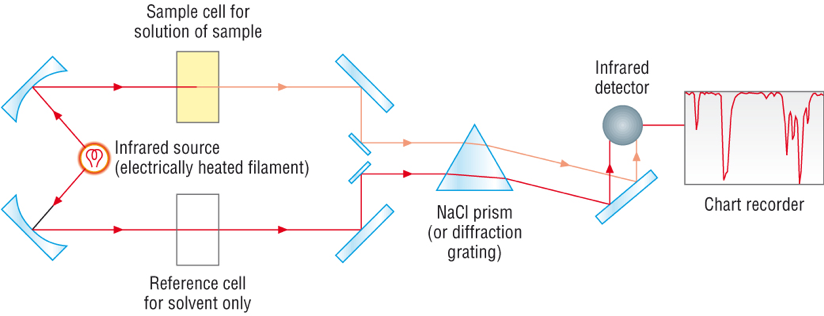29 Infrared (IR) Spectroscopy Theory
Chapter 29 Learning Objectives
- Be able to explain the principle of IR spectroscopy.
- Be able to explain the function of an IR spectrometer.
29.1 Principle of IR Spectroscopy
In IR spectroscopy, how the vibration mode of covalent bonds are affected by absorbing the infrared electromagnetic radiation is studied. Covalent bonds in organic molecules are not rigid sticks, they behave as if they were vibrating springs instead. At room temperature, organic molecules are always in motion that involves several vibration modes, such as stretching, bending, and twisting as illustrated in Fig. 29.1.

Figure 29.1 Vibration Modes of Bonds
Stretching is the vibration occurring along the line of the bond that changes the bond length. Bending is the vibration that like swing, it does not occur along the line, but change the bond angles. The specific bending mode are often referred to by the descriptive terms like scissoring, twisting etc.
One covalent bond may vibrate in different vibrational modes, for example, the C-H bond can be in stretching and bending mode. Each vibrational mode for a given bond occurs with a characteristic ground state frequency, that corresponds to the frequency of infrared region (1013 to 1014Hz, or 2.5 to 17 μm in wavelength) of the electromagnetic spectrum. If a molecule is exposed to infrared radiation, it will absorb the radiation that matches the frequency of the vibration of one of its bonds. The IR radiation absorbed allows the bond to vibrate a bit more, that is increase the amplitude of vibration, but the vibrational frequency will remain the same.
29.2 Working of an IR Spectrometer
In an infrared spectrophotometer (Fig. 29.2) a beam of IR radiation passed through the sample and some radiation is absorbed by the sample, the remaining go through. Another beam of IR radiation pass through the cell with blank (no sample, no absorption) and all light go through. The detector in the instrument record and compare the radiation transmitted through the sample with that transmitted in the absence of the sample. Any frequencies absorbed by the sample will be apparent by the difference. The computer plots the result as a graph showing transmittance vs frequency (in format of wavenumber that will be explained next).


